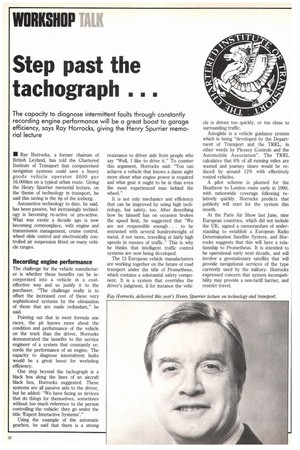Step past the tachograph . . .
Page 124

If you've noticed an error in this article please click here to report it so we can fix it.
The capacity to diagnose intermittent faults through constantly recording engine performance will be a great boost to garage efficiency, says Ray Horrocks, giving the Henry Spurrier memorial lecture
• Ray Horrocks, a former chaiman of British Leyland, has told the Chartered Institute of Transport that computerised navigation systems could save a heavy goods vehicle operator £600 per 16,000Imi on a typical urban route. Giving the Henry Spurrier memorial lecture, on the theme of technology in transport, he said this saving is the tip of the iceberg.
Automotive technology to date, he said, has been passive, but increasingly technology is becoming re-active or pro-active. What was exotic a decade ago is now becoming commonplace, with engine and transmission management, cruise control, wheel slide control and electronically controlled air suspension fitted on many vehicle ranges.
Recording engine performance
The challenge for the vehicle manufacturer is whether these benefits can be incorporated into a vehicle in a costeffective way and so justify it to the purchaser. "The challenge really is to offset the increased cost of these very sophisticated systems by the elimination of those that are made redundant," he said.
Pointing out that in most formula one races, the pit knows more about the condition and performance of the vehicle on the track than the driver, Honocks demonstrated the benefits to the service engineer of a system that constantly records the performance of an engine. The capacity to diagnose intermittent faults would be a great boost for workshop efficiency.
One step beyond the tachograph is a black box along the lines of an aircraft black box, Horrocks suggested. These systems are all passive aids to the driver, but he added: "We have facing us devices that do things for themselves, sometimes without too much reference to the person controlling the vehicle: they go under the title 'Expert Interactive Systems'."
Using the example of the automatic gearbox, he said that there is a strong resistance to driver aids from people who say "Well, I like to drive it." To counter this argument, Horrocks said: "You can achieve a vehicle that knows a damn sight more about what engine power is required and what gear it ought to be in than even the most experienced man behind the wheel."
It is not only mechanics and efficiency that can be improved by using high technology, but safety, too. After describing how he himself has on occasion broken the speed limit, he suggested that "We are not responsible enough. . . to be entrusted with several hundredweight of metal, if not more, travelling at fairly high speeds in masses of traffic." This is why he thinks that intelligent traffic control systems are now being developed.
The 13 European vehicle manufacturers are working together on the future of road transport under the title of Prometheus, which contains a substantial safety component. It is a system that overrides the driver's judgment, if for instance the vehi cle is driven too quickly, or too close to surrounding traffic.
Autoglide is a vehicle guidance system which is being "developed by the Department of Transport and the TRRL, in other words by Plessey Controls and the Automobile Association". The TRRL calculates that 6% of all running miles are wasted and journey times would be reduced by around 12% with effectively routed vehicles.
A pilot scheme is planned for the Heathrow to London route early in 1990, with nationwide coverage following relatively quickly. Horrocks predicts that publicity will start for the system this month.
At the Paris Air Show last June, nine European countries, which did not include the UK, signed a memorandum of understanding to establish a European Radio Determination Satellite System, and Horrocks suggests that this will have a relationship to Prometheus. It is intended to be operational early next decade, and will involve a geostationary satellite that will provide navigational services of the type currently used by the military. Horrocks expressed concern that system incompatibility may provide a non-tariff barrier, and restrict travel.
































































































































